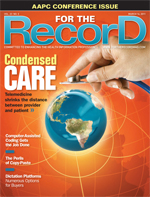 March 14, 2011
March 14, 2011
Dictation Platforms — Numerous Options for Buyers
By Ken Graber
For The Record
Vol. 23 No. 5 P. 8
Remember when choices were easy? Chocolate or vanilla. Window or aisle. AM or FM. Dictaphone or Lanier.
Nowadays, to properly evaluate dictation platforms, it is essential to thoroughly understand not only the technology capabilities that will improve efficiencies and reduce transcription spending but also the total cost to use a platform’s features.
Imagine if we needed to study the relationship between the price of chocolate and elections in the Ivory Coast or had to exclude vanilla beans if they were grown in India before we could enjoy a scoop of ice cream. Essentially, that’s how complicated it’s becoming to select a transcription platform. Every detail matters when it comes time to pull the trigger on a purchase.
In today’s competitive markets, where so much information is readily available at customers’ fingertips, if purchasers do not research and understand the ramifications of their options and their ultimate choice, they could end up with the equivalent of a minivan instead of a MINI Cooper.
Numerous dictation products proliferate the market. Dictation can be recorded using tapes, digital recorders, phone lines, computer microphones, and now even smartphone apps. Selecting the modality based solely on up-front costs could result in a dictation system that does not support current privacy and security regulations for patient health information and one that requires increased personnel time, effort, and expense.
Then there’s the question of adding voice recognition software. Do physicians’ dictation habits resemble a James Joyce novel or is a specific format followed? Voice recognition works well with either style, but the outcomes are entirely different. With minimal effort, structured dictation that closely follows a template can create a final report that is available virtually immediately.
The free-form dictator creates a draft report that can be edited by either the dictator or a trusted entity that has been assigned the task. Both styles have implications with regard to cost, time, and effort. However, the end result is the same.
HIM directors and central purchasing must also consider how the dictation will be saved after the report is completed. The longer previous dictations are stored, the more complex the requirements. Not only do buyers need to consider the size and the amount of media needed to store dictations, but they must also take into account how access to dictation will be tracked so that only those with permission have access. On top of those concerns, HIM directors must institute a plan to recover dictations that are lost due to hardware, software, or human failure and implement a set of policies and procedures in case of a data breach.
It’s no wonder many providers choose to contract these tasks to a third party. But these services are not free, and it seems each one has a slightly different focus and payment terms, making it difficult to ascertain whether the providers’ needs will be met.
Who are these third-party organizations? Some call themselves medical transcription service organizations, while others are dubbed clinical documentation specialists. Still others are individuals who work out of small offices or their homes. No matter who they are or where the business is located, the workflow does not vary much.
Dictation, Storage, Report Creation, Distribution
Contracting with these services is much like purchasing that minivan or MINI Cooper. There are car dealers with no-haggle pricing, and there are those that publish a low base price and expect the consumer to know which options they desire. With dictation products, providers can be charged by the page, the line, the character, visible characters only, time for dictation, time for transcription, or any variation thereof.
Purchasers can also choose how quickly dictation is turned around, where reports are transcribed, the amount of technology used to create documents, how documents are delivered, and how long documents will be made available. And the list of options goes on.
Each choice has an associated cost that the purchaser must weigh against its perceived value. Some services, but not all, itemize costs. All this variability creates havoc when comparing services.
How can providers be sure they are receiving their money’s worth? How can they be certain what was quoted contains answers to the questions they originally posed? Believe it or not, a contract can take several paragraphs to define what constitutes a line and how that relates to the invoice. Now add in all the other options and the transaction becomes even more complicated.
There is no good answer for providers leery of getting the short end of the deal. It’s difficult to feel comfortable with the final decision. Expect there to be lingering doubts; it’s a natural reaction. However, there are steps that can help ease questions surrounding the ultimate choice. Talk to vendors. Ask lots of questions—sometimes the same question worded differently.
Eventually, enough information will be gathered to make the solution more clear. Still, the choice won’t be easy, but at least providers will know they did the best they could with the information that was available.
— Ken Graber is vice president of information services at NJPR Hospital and Medical Support Services.



